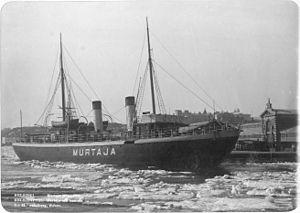Murtaja (1890 icebreaker)

Murtaja at the port of Helsinki in the 1890s.
|
|
| History | |
|---|---|
| Name: | Murtaja |
| Namesake: | Finnish for "icebreaker" |
| Owner: | Finnish Board of Navigation |
| Port of registry: | Helsinki |
| Ordered: | 25 May 1889 |
| Builder: | Bergsunds Mekaniska Verkstads AB, , Sweden |
| Cost: | 445,000 Swedish kronor |
| Launched: | 23 December 1889 |
| Completed: | 30 March 1890 |
| Decommissioned: | 3 May 1958 |
| In service: | 1890–1958 |
| Fate: | Broken up in 1958 |
| General characteristics | |
| Type: | Icebreaker |
| Tonnage: | 676 GRT |
| Displacement: | 930 tons |
| Length: | |
| Beam: |
|
| Draught: |
|
| Boilers: | Four coal-fired boilers |
| Engine: | Two-cylinder tandem compound steam engine, 1,600 ihp (1,200 kW) |
| Propulsion: | Four-bladed propeller |
| Sail plan: | Two masts; two staysails and two Bermuda sails |
| Speed: | 12.5 knots (23.2 km/h; 14.4 mph) in open water |
| Crew: | 28 |
| Armament: | Armed during the Second World War |
Murtaja was a Finnish state-owned steam-powered icebreaker. Built in 1890 by Bergsunds Mekaniska Verkstads AB in , Sweden, she was the first state-owned icebreaker of Finland and one of the first purpose-built icebreakers in the world.Murtaja remained in service for 68 years until she was decommissioned and broken up in 1958 after having been replaced by the diesel-electric Karhu.
The history of winter navigation in Finland dates back to the 17th century when mail was carried year-round between Turku, Finland and Grisslehamn, Sweden, over the Sea of Åland. During the winter season, the postmen used ice boats, strengthened sleigh-boats that were pushed over the ice until it gave in under the weight of the boat. Once in water, the men began rocking the boat back and forth until it slowly began to break the ice and proceed towards open water. The mail route was often called the most dangerous in Europe.
In the 1860s there were plans to start year-round traffic from the Hanko, the southernmost tip of the continental Finland, but even people in the Finnish Pilot and Lighthouse Authority were doubtful about the project – the director's aide was quoted saying that this close to the 60th parallel north winter traffic to Hanko would forever be a distant dream. Despite the opposition, a harbour and railway connection were built in 1872–73. Several domestic and foreign shipping companies attempted year-round traffic with varying commercial success, but the port of Hanko remained closed for several months nearly every year.
In 1889, the Finnish factory owners encouraged the Danish shipping company Det Forenede Dampskibs-Selskab to send their icebreaker, Bryderen, to the northern Baltic Sea and try to open a path to the icebound port of Hanko. Bryderen, the most powerful icebreaker in Europe at that time, had 1,000 ihp (750 kW) steam engine and could easily break ice up to 45 centimetres (18 in) thick. As word got around, people in the Senate of Finland became interested in the experiment as its result would affect the general opinions regarding icebreakers and winter navigation.
...
Wikipedia
